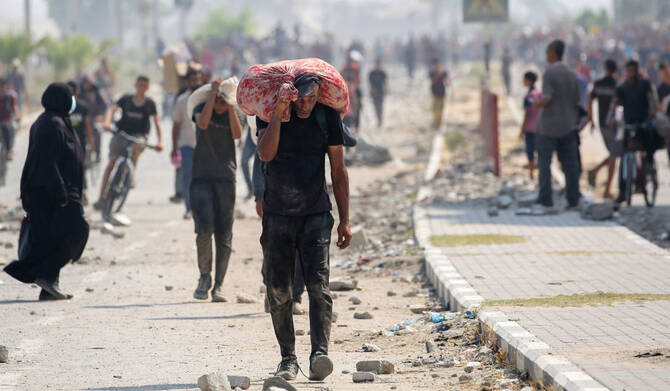
- ARAB NEWS
- 27 Jul 2025

PARIS: The UN and NGOs are warning of an imminent famine in the Gaza Strip — a designation based on strict criteria and scientific evidence.
But the difficulty of getting to the most affected areas in the Palestinian territory, besieged by Israel, means there are huge challenges in gathering the required data.
The internationally agreed definition for famine is outlined by the Integrated Food Security Phase Classification, or IPC, an initiative of 21 organizations and institutions including UN agencies and aid groups.
The IPC definition has three elements. Firstly, at least 20 percent of households must have an extreme lack of food and face starvation or destitution. Second, acute malnutrition in children under five exceeds 30 percent.
And third, there is an excess mortality threshold of two in 10,000 people dying per day.
Once these criteria are met, governments and UN agencies can declare a famine.
Available indicators are alarming regarding the food situation in Gaza.
“A large proportion of the population of Gaza is starving,” according to the World Health Organization’s chief, Tedros Adhanom Ghebreyesus.
Food deliveries are “far below what is needed for the survival of the population,” he said, calling it “man-made … mass starvation.”
Doctors Without Borders, or MSF, said on Friday that a quarter of all young children and pregnant or breastfeeding women screened at its clinics in Gaza last week were malnourished, blaming Israel’s “deliberate use of starvation as a weapon.”
Almost a third of people in Gaza are “not eating for days” and malnutrition is surging, the UN’s World Food Programme said Friday.
The head of Al-Shifa Hospital in Gaza City on Tuesday said that 21 children had died across the Palestinian territory in the previous 72 hours “due to malnutrition and starvation.”
The very few foodstuffs in the markets are inaccessible, with a kg of flour reaching the exorbitant price of $100, while the Gaza Strip’s agricultural land has been ravaged by the war.
According to humanitarian organizations, the 20 or so aid trucks that enter the territory each day — vastly insufficient for more than 2 million hungry people — are systematically looted.
“It’s become a technical point to explain that we’re in acute food insecurity, IPC4, which affects almost the entire population. It doesn’t resonate with people,” said Amande Bazerolle, in charge of MSF’s emergency response in Gaza. “Yet we’re hurtling toward famine — that’s a certainty.”
NGOs and the WHO concede that gathering the evidence required for a famine declaration is extremely difficult.
“Currently, we are unable to conduct the surveys that would allow us to formally classify famine,” said Bazerolle.
She said it was “impossible” for them to screen children, take their measurements, or assess their weight-to-height ratio.
Jean-Raphael Poitou, Middle East program director for the NGO Action Against Hunger, said the “continuous displacements” of Gazans ordered by the Israeli military, along with restrictions on movement in the most affected regions, “complicate things enormously.”
Nabil Tabbal, incident manager at the WHO’s emergency program, said there were “challenges regarding data, regarding access to information.”
AFP